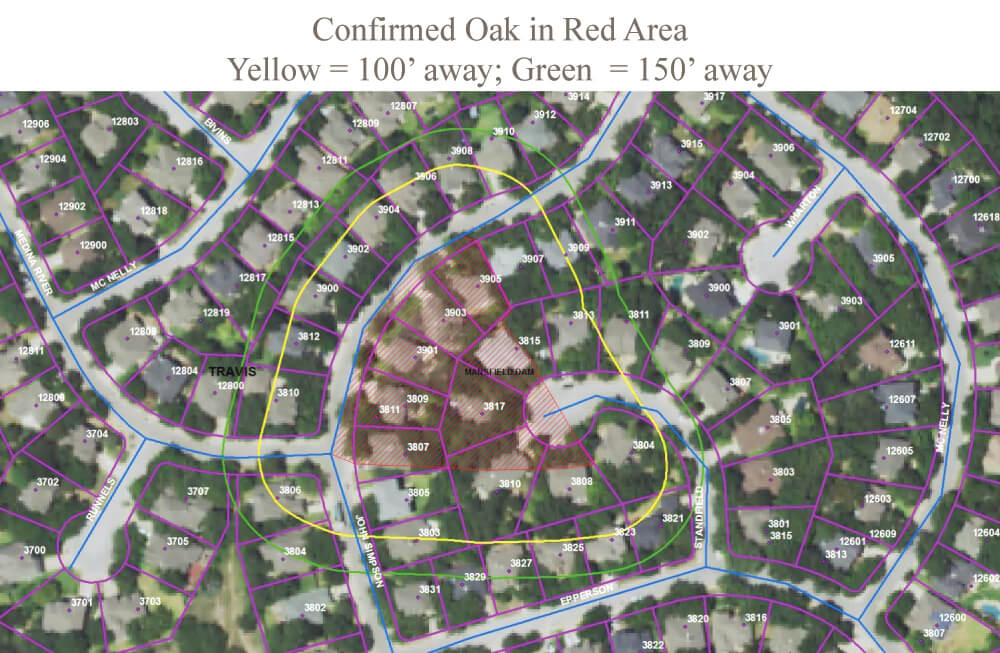
Oak wilt has been confirmed in the Plateau neighborhood in Steiner Ranch in approximately 30 trees, shown in red. The yellow line shows 100 feet away from the affected trees and the green line show 150 feet away.
By CASSIE MCKEE, Four Points News
A July 14 neighborhood meeting drew 85 Steiner Ranch residents to learn about ways to combat oak wilt, an infectious disease that has been confirmed in the Plateau neighborhood in Steiner Ranch as well as along Selma Hughes Park Road off of Quinlan Park Road.
“The purpose of these meetings is to educate residents about oak wilt as well as oak wilt prevention and containment,” said Steiner Ranch HOA communications coordinator Meredith Hamrick. “SRMA and SRROA Boards will determine next steps regarding possible HOA oak wilt policies.”
The meeting was led by Clay Bales, forester with Texas A&M Forest Service. Bales gave a presentation that explained the causes of oak wilt and ways to fight it.
While only approximately 30 trees locally are currently showing symptoms, if not treated and addressed, oak wilt will continue to grow and spread. One reason this is such a big issue is that mature, live oaks are all connected, Bales said.
Oak wilt moves in two ways, above ground in red oaks through mat beetles and below ground, in the roots. The roots, in time, grow together from lot to lot and connect throughout a community, he said.
Out of all of the oak varieties, red oaks and live oaks are most susceptible to the disease.
“The only way to stop (the spread of the disease) is sever roots four feet deep with trenching,” Bales said.
Another way to fight oak wilt is by injecting a fungicide into all live oaks or high-valued live oaks, Bales said. Injecting trees with fungicide can help preserve the canopies of individual trees that would normally die from oak wilt.
“Injections do not contain the disease,” Bales said. “It still goes through the roots but it’s a way for individual homeowners to protect trees that they value.”
Questions from July 14 meeting
At the meeting, he said some homeowners said they were injecting their trees despite being farther than 150 feet away from an infected tree.
“I just tried to reinforce why we recommend only injecting out 150 feet from the last tree that has symptoms,” Bales said. “The disease moves about 75 feet a year. You need to inject just before the disease gets there and not give the tree time to put on three years of new growth that are unprotected.”
He said a tree only uses the outer one to three years of growth. If it takes three years for the disease to get to the tree, then the tree is unprotected.
“As the disease moves, they’ll need to inject again,” he said.
Another question raised at the meeting was what should be done with affected trees. Bales said that when red oaks become diseased or die, they must be destroyed because they can produce an above-the-ground fungus leading to further spread of the disease.
When live oaks become diseased, they do not produce the same fungus, so homeowners do not have to get rid of the tree immediately.
One positive sign is that the disease seems to be stopping at John Simpson Trail due to five-foot trenches that were built years ago for water and wastewater lines.
“Maybe we’ll get lucky and the disease will die out,” Barnes said. “We may know more in a year but right now it appears to be holding.”
Certified arborists can help
Barnes noted that his role is to study the disease at the population level and he does not make appointments to look at individual trees. He said homeowners who have concerns about their trees should contact a certified arborist.
“There are hundreds of arborists who can create a personal plan for each homeowner,” he said.
To find an arborist, he encouraged residents to visit www.treesaregood.com. Residents can also find arborists specifically trained in oak wilt at www.TexasOakWilt.org.
For those who were not able to attend the July 14 meeting, another meeting will be held at 6 p.m. on Aug. 3 at the Towne Square Community Center.

